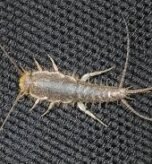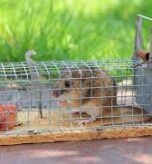Introduction
The discovery of rodents within a home often elicits feelings of unease and concern among homeowners. These resourceful creatures, including mice and rats, are capable of entering structures through incredibly small openings—mice, for instance, can fit through spaces as small as a nickel, while rats can exploit gaps as narrow as half an inch. Rodents frequently seek indoor shelter, particularly during colder seasons, and their presence extends beyond mere nuisance, posing significant risks to health, safety, and property.
Identifying a Rodent Infestation
Accurate identification of a rodent infestation is crucial for effective control. Several key indicators signal the presence of rodents:
Visual Evidence
• Droppings: Rodent droppings are a primary indicator. Mouse droppings are typically small (approximately 1/8 to 1/4 inch long), smooth, and have pointed ends, often resembling chocolate sprinkles. They are usually scattered. Rat droppings are larger, typically 1/2 to 3/4 inch long (up to one inch), cylindrical, and can have blunt or slightly pointed ends, similar to a grain of cooked rice, raisins, coffee beans, or burritos. They are often found in larger groupings.
Rodents are significant vectors for numerous diseases and can introduce harmful bacteria and viruses into human and pet environments. Direct contact, contaminated surfaces, consumption of contaminated food, or inhalation of airborne particles from their waste can lead to serious health issues.
Diseases Transmitted by Rodents and Their Waste
• Hantavirus Pulmonary Syndrome (HPS): A severe and often fatal respiratory disease, primarily spread by inhaling airborne particles from dried rodent urine, faeces, or nesting materials. Mortality rates can be as high as 38-50%.
• Leptospirosis: A bacterial infection found in rodent urine and faeces, transmissible through direct contact with contaminated water, soil, or surfaces, or by pets ingesting contaminated urine. It can lead to kidney and liver failure and can be fatal.
• Rat-Bite Fever (RBF): A bacterial illness spread through bites, scratches, or ingestion of food/water contaminated with rat faeces. If untreated, RBF can be life-threatening, with a mortality rate of approximately 10%.
• Salmonellosis: Rodents can contaminate food preparation areas and food sources with Salmonella bacteria via their droppings, causing symptoms like diarrhoea, abdominal cramps, and fever.
• Lymphocytic Choriomeningitis (LCM): A viral infection spread through exposure to contaminated rodent droppings, urine, or saliva. Symptoms resemble the flu, but in rare cases, it can cause severe inflammation of the brain and spinal cord. For pregnant individuals, LCM can result in serious birth defects or miscarriage.
• Toxoplasmosis: A parasite that can be transmitted if pets consume infected rodents. It is particularly dangerous for pregnant pets or young animals, potentially leading to loss of litters or severe symptoms.
• Allergies: Rodent faeces and urine contain allergens that can exacerbate asthma and allergic symptoms in humans. A single mouse can produce up to 9,000 droppings annually.
Risks to Property
Beyond health concerns, rodents can cause significant structural and electrical damage by gnawing through wires, which can lead to electrical fires. They also contaminate surfaces with waste, rendering food inedible and increasing spoilage.
Comprehensive Rodent Prevention Strategies
Proactive measures are essential to deter rodents from entering and infesting homes. An effective rodent control programme combines sanitation, rodent proofing, and elimination.
Structural Exclusion (Rodent Proofing)
• Seal Entry Points: Rodents require minimal space to enter. Seal all cracks and holes on the exterior of the home, especially where utilities and pipes enter, using materials like caulk, steel wool, lath screen, metal sheeting, cement, or hardware cloth. Ensure gaps are no larger than 1/4 inch for mice and 1/2 inch for rats.
• Secure Doors and Windows: Install door sweeps on exterior doors and ensure windows fit snugly and are in good repair. Repair damaged screens.
• Vent and Chimney Screens: Screen all vents and openings to chimneys with heavy mesh or 16-20 gauge galvanized hardware cloth.
• Foundation and Crawl Spaces: Replace loose mortar around the basement foundation and windows. Properly screen or securely cover any access points to crawl spaces, ensuring no gaps.
Sanitation and Habitat Modification
• Food Storage: Store all food, including pet food, in airtight, thick plastic, metal, or glass containers with tight-fitting lids. Avoid leaving pet food or water bowls out overnight.
• Waste Management: Dispose of garbage regularly in rust-resistant, watertight receptacles with tight-fitting lids. Place all garbage in plastic bags and seal them before putting them in bins. Keep outdoor cooking areas and grills clean.
• Eliminate Outdoor Food Sources: Promptly remove unharvested or fallen fruits and nuts from trees, and decaying garden vegetables. Prevent bird seed from accumulating on the ground beneath feeders. Keep composting bins at least 100 feet from the house.
• Reduce Harborage: Eliminate all moisture sites, such as leaking pipes and clogged drains. Store firewood at least 20 feet away from the house and elevate it at least 18 inches off the ground and 12 inches from walls/fences. Trim shrubbery and dense ground plants to maintain at least 12 inches of open area beneath them, and clear brush and weeds around the home. Remove abandoned vehicles, old furniture, or unused equipment from the property. Keep attics, basements, and crawl spaces well-ventilated and dry.
• Regular Inspection: Inspect items brought into the home, such as boxes and grocery bags, for signs of pests. Regularly inspect the home’s exterior and interior for new entry points or signs of rodent activity.
Natural Deterrents
• Some sources suggest that scents like mint, lavender, citronella, peppermint oil, and cinnamon may repel rats, and placing cotton balls with vinegar where nests are suspected could be effective.
Safe Cleanup of Rodent Droppings
Given the health risks, cleaning up rodent waste requires strict adherence to safety protocols.
Essential Protective Gear
Always wear rubber or plastic gloves, a dust mask (N95 or respirator), and protective goggles. For heavy infestations, disposable coveralls or clothes that can be immediately washed are recommended.
Cleanup Process
1. Ventilate the Area: Open all doors and windows for at least 30 minutes before cleaning to air out the space.
2. Prepare Disinfectant: Use a general-purpose household disinfectant or a fresh bleach solution (1.5 cups household bleach mixed with 1 gallon of water, or a 1:9 bleach-to-water ratio).
3. Disinfect First, Do Not Sweep/Vacuum: Crucially, do not sweep or vacuum dry rodent droppings, urine, or nesting materials. This can aerosolise harmful particles and viruses into the air. Instead, spray the contaminated areas with the disinfectant solution until thoroughly wet, and let it soak for at least 5 minutes.
4. Wipe Up Waste: Use paper towels or a damp cloth to carefully wipe up the saturated droppings and cleaning product.
5. Dispose of Waste Safely: Place all soiled paper towels, droppings, and used traps (if not reusing) into a plastic bag, seal it, and then place it into a second plastic bag, sealing that one as well. Dispose of these double-bagged materials in a covered outdoor garbage bin.
6. Clean and Disinfect Surfaces: Mop or sponge all hard surfaces, including floors, countertops, cabinets, and drawers, with the disinfectant solution.
7. Post-Cleanup Hygiene: Wash gloved hands with soap and water before removing gloves. After removing gloves, wash hands thoroughly with soap and warm water again. Launder contaminated clothing, bedding, or stuffed animals with hot water and detergent, and machine dry on a high setting or air dry in the sun. Shampoo carpets and upholstered furniture with a commercial disinfectant or steam cleaner. Non-washable items like books can be left outdoors in direct sunlight for several hours or in a rodent-free area for three to six weeks.
Special Precautions
• Pregnant Individuals: Pregnant individuals should not attempt to clean or handle rat droppings due to the severe risks posed to both their health and that of their unborn child, including miscarriage. A pest control professional should be contacted in such cases.
• Heavy Infestations: For homes with heavy rodent infestations, or where rodent-borne diseases have been confirmed, contact the local or state health department and consider professional cleanup services.
• Vehicles and HVAC Systems: If rodents are found in vehicles or heating/cooling ventilation systems, professional assistance is recommended for inspection and disinfection.
Professional Pest Control Intervention
If signs of a rodent infestation are present, prompt action is advised, as rodents reproduce quickly. While some DIY methods exist, for suspected or severe infestations, contacting a licensed pest control professional is the most effective and safest course of action. Professionals can inspect the property, accurately identify the extent of the problem, and implement tailored solutions, including trapping and removal services. They understand rodent behaviour, such as rats’ wariness of new objects, which can make DIY traps initially ineffective.



